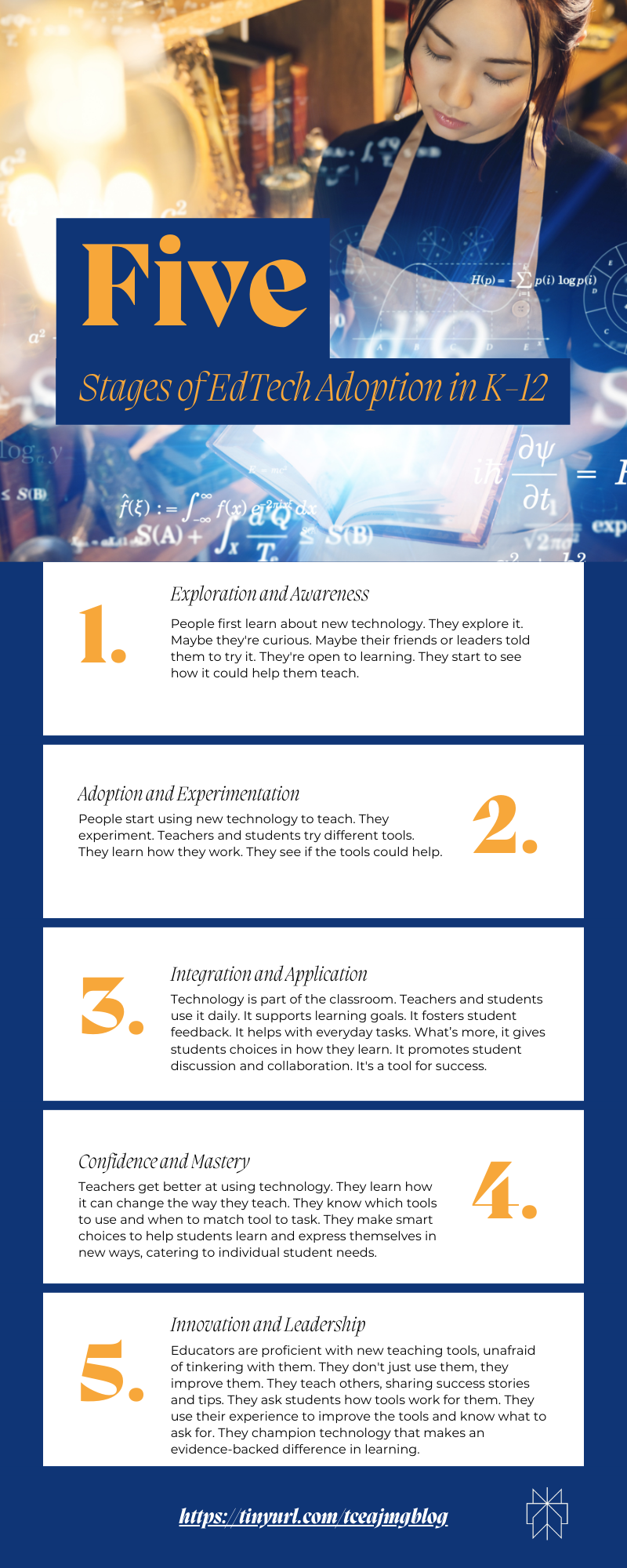When teachers grow in confidence, they change the way they teach using technology. This is Stage 4 of the Five Stages of Ed Tech Adoption in K-12; the last stage is Innovation and Leadership (Stage 5). Let’s dig into these last two stages.

Why Spend Time on Ed Tech?
It’s easy to see the challenges educators face. Without the factors outlined below, ed tech adoption fails. This is in the face of research about ed tech effectiveness. Consider this quote:
…the scientific consensus suggests that educational technology can have a positive impact on student achievement. Its effectiveness is not guaranteed and depends on a range of factors. Those factors include the quality of implementation, the educational context, and the support provided to teachers and students.
OECD Publishing – Students, Computers and Learning Making the Connection
Worse, the Reboot Foundation states that their data suggests that:
“…technology may not always be used in a way that prompts richer forms of learning.”
They point out the following:
- Schools and teachers should be more careful about when—and how—education technology is deployed in classrooms.
- Moderate use of technology is often the most effective for younger students.
- Experts recommend limiting the use of devices for young children.
- Technology seems the least helpful for younger students learning to read.
- Non-digital tools work better for younger students who are mastering the basics of language.
- Digital tools that provide immediate instructional feedback can show a high impact.
- Technology can be particularly beneficial for promoting richer thinking among older students.
In light of this information, it might be safe to draw the same conclusion as OECD Publishing’s report.
…ensuring that every child attains a baseline level of proficiency in reading and mathematics seems to do more to create equal opportunities in a digital world than can be achieved by expanding or subsidizing access to high-tech devices and services…students who use computers very frequently at school do a lot worse in most learning outcomes, even after accounting for social background and student demographics.
OECD Publishing – Students, Computers and Learning Making the Connection
Teaching kids reading and math is key to equality. More tech doesn’t help as much. Using computers too much at school can hurt grades, no matter where a kid comes from. With that in mind, what can teachers do to harness ed tech?
Stage 4: Confidence and Mastery
Teachers have access to many digital tools. How can they ensure these contribute to effective teaching? In this stage:
Teachers improve with technology. They learn how it changes teaching. They pick the right tools for each task. They make the right choices when helping students learn and express themselves. With technology, teachers are able to better meet the needs of each pupil.
In this stage, technology supports learning in these ways:
- Scaffolding. Create scaffolded learning experiences for students using inquiry-based projects and technology. These present learning as a series of challenges students must navigate.
- Active Learning. Digital tools facilitate problem-solving, discussion, and reflection activities through interactive simulations, collaborative platforms, and opportunities for real-world use.
- Feedback. Teachers can provide feedback to students through prompt assessments. Students use the information to better control their learning.
- Personalization. Teachers can use assessment feedback to better customize learning projects and activities for students.
For teachers, professional learning involves self-guided movement to become more:
- Collaborative with others to design lessons and refine classroom activities.
- Observational of others’ classrooms and how they deploy technology in those situations.
- Reflection-oriented to conduct self-assessments and come prepared to engage in professional learning communities (PLCs).
At TCEA’s events, educators dive into technology, learning to gain confidence and skills. They find workshops and expert talks on new teaching tools and methods to master them. Additionally, the TCEA TechNotes blog offers tips, tools, and research. TCEA is dedicated to supporting teachers in their confidence, mastery, and innovation.
Stage 5: Innovation and Leadership
In this final stage, educators proficient in new tools work to improve them. To borrow a Star Wars analogy, they progress to a level where they are fine-tuning their lightsabers.
In other words, they know how to use new teaching tools and are unafraid to tinker with them. They also:
- Teach others, sharing success stories and tips.
- Conduct action research with students to gauge their success at using technology.
- Use their experience to improve the tools and how students use them; plus, they know how to assess success.
- Champion technology that makes an evidence-backed difference in learning.
That final bullet means having a solid understanding of evidence-based education. Some examples in the classroom include:
- Interactive video lessons with built-in assessments (consider using EdPuzzle)
- Digital storytelling with video editing tools (such as Screencastify)
- Formative assessment that ensures instant feedback for students (try Kahoot! or Quizizz)
- Illustrating advanced processes, such as exploring photosynthesis with digital simulations (try Photosynthesis Lab by Glencoe/McGraw-Hill)
Parting Thoughts
As teachers embrace and improve their technology skills, they start changing how they teach. By Stage 4, they use digital tools well. They make lessons personal and engaging. They think in a critical manner and connect concepts and ideas. Teachers listen to students’ feedback to improve. In Stage 5, teachers lead and innovate. They help make and improve digital tools. They teach others, and push for proven tech that can change education. Embrace the Five Stages of Ed Tech Adoption in K-12 and take your teaching, and your students’ learning, to new heights.

